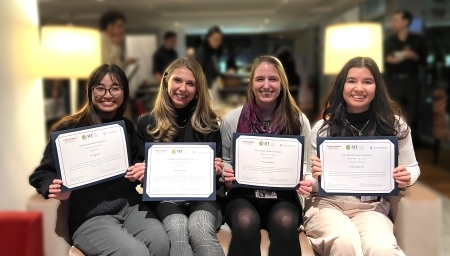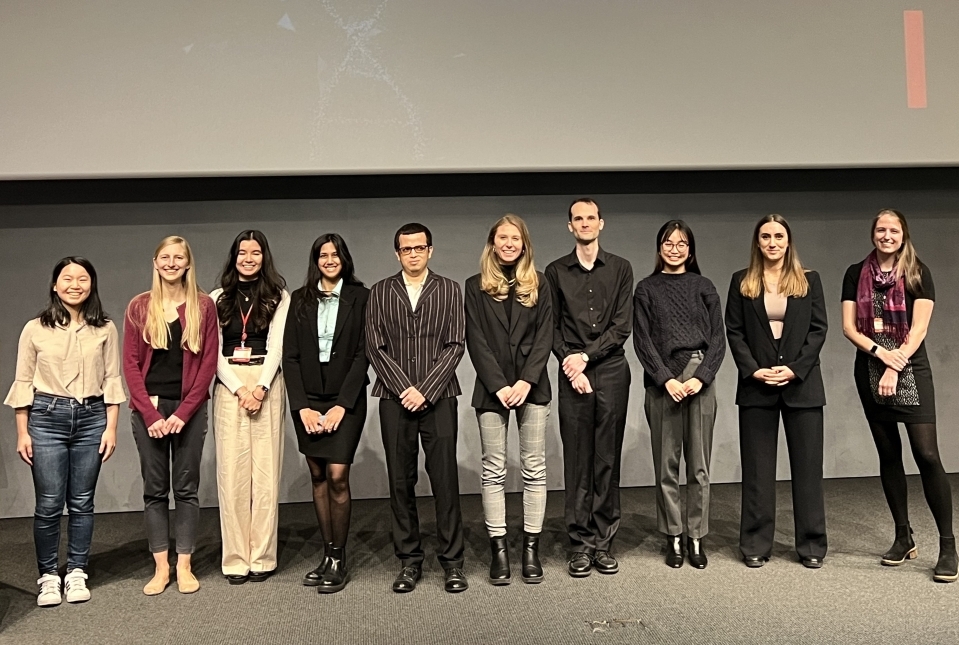Three minutes and one projected slide–that’s all each graduate student had to present a big-picture research goal to a non-specialist audience in a way they could understand and appreciate.
The eleven students from the Weill Cornell Graduate School of Medical Sciences and the Gerstner Sloan Kettering Graduate School of Biomedical Sciences participated in the eighth annual Three-Minute Thesis (3MT®) competition, which challenged the young scientists to trim the scientific jargon and share their thesis projects creatively.
Approximately 150 attendees—faculty, postdocs and students from across disciplines, as well as family and friends—packed the Rockefeller Research Labs Auditorium at Memorial Sloan Kettering on Nov. 13. And they were not disappointed. The audience was entertained with inventive storytelling, as the students shared complex scientific concepts, squeezing in some humor along the way. A panel of judges, including past winners, evaluated the presentations for accessibility and accuracy.
The University of Queensland, Australia founded this competition as an opportunity for doctoral students to develop and showcase their research communication skills.
The Top Presenters
Imagine a neuron represented as grandma texting on her 2000s-era flip phone. Other mentions included Sherlock Holmes investigating suspect viruses, the video game “Among Us” and the “Fast and Furious” movie franchise. Through pop culture references and analogies from everyday life, the audience learned about cutting-edge research in neuroscience, vaccines, cancer and more.
The top three presenters and a special audience-choice awardee each received a $500 grant.

Top presenters (left to right): Chi Nguyen, Kristin Fullerton, Kelsey Hopland, and Chloe Lopez-Lee.
Kristin Fullerton, a fourth-year doctoral student in the Physiology, Biophysics and Systems Biology graduate program at Weill Cornell Medicine, was named the first-place winner. “I enjoyed having the opportunity to talk about science, and not just the complicated details, but the bigger picture so that a wider audience could appreciate the importance of research,” said Fullerton after the event.
In her presentation, “Seldane: friend or foe?” Fullerton introduced Jane, a fictional character who is miserable with watery eyes, runny nose and sneezing due to allergies. Jane takes Seldane, the first non-drowsy antihistamine that was released in 1985, to get back to work. Though this drug worked for most, it was taken off the market in 1997 after causing fatal heart arrhythmias, or irregular heartbeats, in some people. Heart arrhythmias occur when the electrical signals that tell the heart to beat don't work properly.
But why were most people fine, while a few had this deadly reaction? Fullerton has developed a computational model to predict and understand the risk of cardiac arrhythmias. She hopes this will lead to better therapies and prevent drugs like Seldane from entering the market.
Kelsey Hopland, a sixth-year neuroscience doctoral student at Weill Cornell Medicine doing research in a lab at Memorial Sloan Kettering, was awarded second place. She first asked the audience to, “consider the similarities between neuroscientists and zombies – they both love brains.” In her presentation, “Glioma-associated microglia: from resident macrophages to resident evil,” Hopland shared a macabre tale of how microglia turn into zombies when a brain cancer called glioma strikes.
Microglia are resident immune cells of the brain that constantly patrol and respond to pathogens and damage. However, glioma cells send out signals that transform healthy immune cells into a “zombie” state. The zombie microglia wreak havoc in the brain—instead of protecting and maintaining the brain, they damage healthy cells and contribute to cancer progression. She recreates this interaction in a petri dish to identify ways to block the transformation.
“The Three-Minute Thesis competition was a valuable experience in honing the communication and presentation skills we need as professionals,” said Hopland who plans to pursue a career in science policy.
Chi Nguyen, a sixth-year student in immunology at Memorial Sloan Kettering, received the third-place prize for her presentation, “Friends turn foes: impact of non-antibiotic medications on the intestinal microbiota.” Her slide showed a thriving garden with diverse, colorful flowers that represented the healthy, human intestinal microbiota—all the microorganisms that live in the human gut, such as bacteria, viruses and fungi.
She illustrated how some medicines that treat infections, like antibiotics, can also wipe out beneficial bacteria as collateral damage, resulting in poor gut health. Nguyen’s research is exploring the impact of “eco-friendly,” non-antibiotic drugs used by cancer patients on the gut microbiota. She found that choosing medications which promoted a healthy gut microbiome was critical to improving treatment outcomes in these patients.
“Good science doesn’t happen in a vacuum,” said Nguyen. “Scientists need to be good communicators to engage the public in scientific discourse and help increase their understanding of science and technology.”
Chloe Lopez-Lee, a sixth-year doctoral student in neuroscience at Weill Cornell Medicine, received the People’s Choice Award, which was decided by the audience. For her presentation, “Do male and female brains respond differently to disease?” Lopez-Lee discussed her research on sex differences in the brain's response to Alzheimer's, multiple sclerosis and Parkinson’s disease. A Marvel comics fan, she likened the activation of microglia, the immune cells in the brain, to Bruce Banner turning into the Hulk.
She discovered that microglia responded to neurodegenerative disease differently in female and male brains. In female brains, microglia acted like the Hulk, tearing into everything in their path, and in male brains more like Bruce Banner, calmer and controlled. The uncontrolled, prolonged activation of microglia in the “Hulk” state can be damaging. Understanding this difference may help in developing better therapeutic approaches for neurodegenerative diseases.
“I learned a lot about communicating better,” said Lopez-Lee. “It was difficult but worth the effort because events like this help people realize that they like science and may help recruit future scientists who have their interests piqued.”
The winners’ presentations can be viewed at the Weill Cornell Graduate School of Medical Sciences site. The event was co-organized by Dr. Aubrey DeCarlo, assistant director of career and professional development at the Weill Cornell Graduate School of Medical Sciences, and Dr. Thalyana Stathis, associate director of the Office of Career and Professional Development at Memorial Sloan Kettering Cancer Center.

